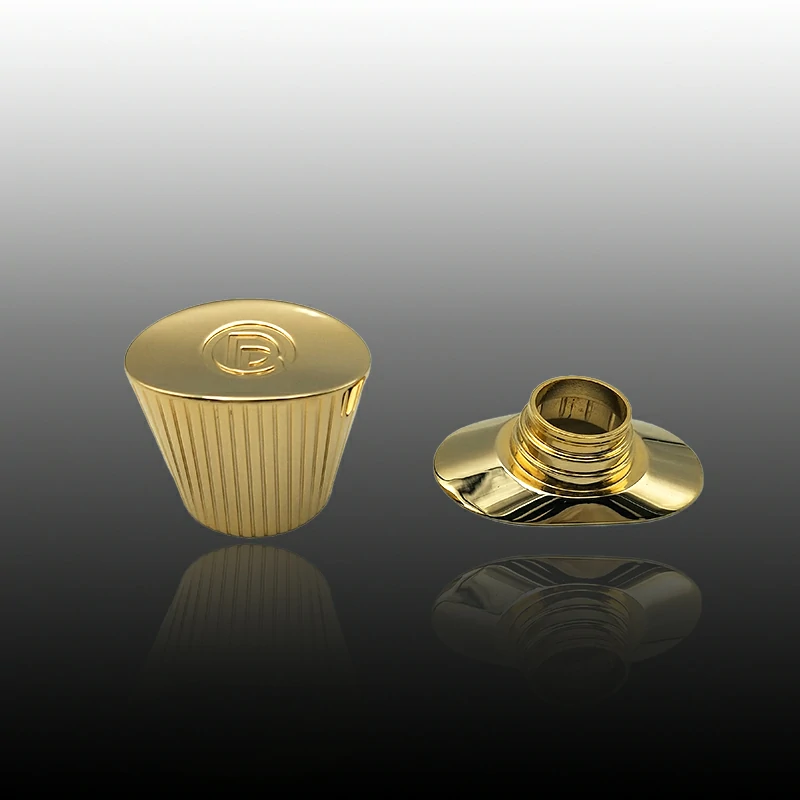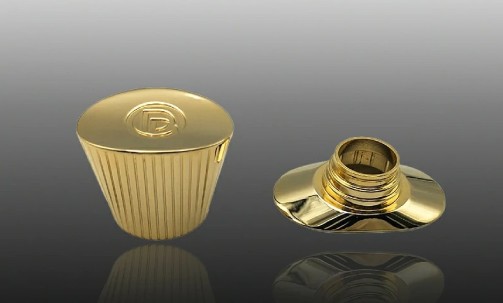Introduction
Choosing a suitable material for a perfume cap is crucial for preserving the perfume bottle’s fragrance and overall aesthetic. A well-crafted perfume cap protects the perfume from external elements and adds to the product’s visual appeal, influencing consumer perception and purchase decisions. This article will explore the various materials used for perfume caps, discussing their advantages, disadvantages, and suitability for different needs, helping you make an informed choice when purchasing from a Perfume Cap manufacturer.

Factors to Consider When Choosing a Perfume Cap Material
When selecting a perfume cap material, several factors come into play:
- Durability: The material should withstand regular use without deteriorating.
- Aesthetics and Design: It should complement the perfume bottle and reflect the brand’s image.
- Compatibility with Perfume Ingredients: Some materials may react with the perfume’s components, altering its scent.
- Environmental Impact: Consumers increasingly prefer eco-friendly materials.
- Cost: The material’scost of the material can significantly affect the overall budget.
Common Materials Used for Perfume Caps
Plastic
Plastic is a versatile and widely used material for perfume caps. It comes in various types, such as ABS (Acrylonitrile Butadiene Styrene) and PP (Polypropylene).
- Advantages: Lightweight, cost-effective, and available in numerous shapes and colours.
- Disadvantages: Less durable than other materials and can appear less premium.
- Common Uses: Often used for mass-market fragrances where cost is a significant factor.
Metal
Metal caps, such as those made from aluminium or zinc alloy (e.g., Zamac Perfume Cap), offer a high-end look and feel.
- Advantages: Highly durable, luxurious appearance, and can be intricately designed.
- Disadvantages: Heavier and more expensive than plastic.
- Typical Applications: Ideal for premium and luxury perfumes.
Wood
Wood perfume caps bring a natural and unique aesthetic to the perfume bottle. Common types include maple and oak.
- Advantages: Eco-friendly, unique texture and appearance.
- Disadvantages: It can be prone to damage from moisture and may be more expensive.
- Use Cases: Often used in niche and artisanal fragrances where sustainability and uniqueness are valued.
Glass
Glass caps, typically made from borosilicate, offer a sophisticated and transparent option.
- Advantages: Elegant look, can be moulded into various shapes, non-reactive with perfume ingredients.
- Disadvantages: Fragile and heavier than other materials.
- Examples: Frequently used in high-end perfumes where transparency and purity are essential.
Composite Materials
Composite materials combine different substances, such as plastic-metal hybrids, to leverage the benefits of each component.
- Advantages: Balance between durability, aesthetics, and cost.
- Disadvantages: It can be complex to manufacture and may need to capture the benefits of pure materials fully.
- Ideal Situations: Suitable for brands looking for a blend of strength, beauty, and affordability.
Comparison of Different Materials
When choosing a perfume cap, you must compare the different materials to see which best fits your needs. Here’s a detailed comparison:
| Material | Durability | Aesthetics | Compatibility | Environmental Impact | Cost |
| Plastic | Medium | Variable | High | Low | Low |
| Metal | High | High | High | Medium | High |
| Wood | Medium | High | High | High | Medium |
| Glass | Low | High | Very High | Medium | High |
| Composite | High | Variable | High | Variable | Medium |
Plastic caps are a budget-friendly option suitable for various designs but may lack the premium feel of other materials.
Metal caps, such as Zamac Perfume Caps, offer a luxurious and durable option perfect for high-end brands.
Wood provides an eco-friendly and unique touch, though it requires careful handling.
Glass caps exude elegance but are fragile and best suited for static display.
Composite materials balance durability and aesthetics and are often used in custom designs.
Trends in Perfume Cap Materials
Sustainable and Eco-friendly Materials
There has been a growing trend towards using sustainable and eco-friendly materials in perfume packaging in recent years. Wood and biodegradable plastics are becoming popular as consumers become more environmentally conscious. Some Perfume Cap manufacturers are experimenting with recycled materials and innovative, sustainable options.
Innovations in Perfume Cap Design
Innovation in design is also a key trend. Perfume caps are now designed with intricate detailing, unique shapes, and advanced functionality. Custom Perfume Cap solutions allow brands to create distinctive and memorable packaging that stands out on the shelves.
Market Trends and Consumer Preferences
Consumer preferences are shifting towards products offering aesthetic appeal and practical benefits. There is a growing demand for caps that look good, protect the perfume, and are easy to use. This has led to increased interest in composite materials that combine the best features of different substances.
Tips for Choosing the Right Perfume Cap Material
Selecting the suitable material for your perfume cap requires careful consideration of several factors:
- Matching the Cap Material with the Bottle and Brand Image: Ensure the cap complements the bottle design and reflects your brand’s identity. A Zamac Perfume Cap might be perfect for a luxury brand, while a wooden cap could be ideal for an artisanal fragrance line.
- Considering the End-user Experience: Think about how the cap feels and functions in the hands of the consumer. It should be easy to handle and secure.
- Budget Considerations: Balance between quality and cost. While metal and glass may offer a premium feel, plastic and composite materials can provide a more cost-effective solution.
- Long-term Durability and Maintenance: Consider how the cap will hold up over time, especially if it’s a material prone to wear and tear or damage from exposure to perfume ingredients.
Conclusion
In conclusion, choosing the suitable material for a perfume cap is a crucial decision that impacts the perfume’s functionality and aesthetic appeal. You can select the best material that meets your needs by considering durability, design, compatibility, environmental impact, and cost. Whether you opt for the luxury of a Zamac Perfume Cap, wood’s sustainability, or plastic’s versatility, make sure it aligns with your brand image and enhances the overall consumer experience.

